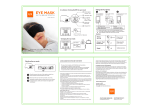
2
Health and safety information
Do not swing your camera by the strap. This may cause injury •
to yourself or others.
Do not paint your camera, as paint can clog moving parts and •
prevent proper operation.
Paint or metal on the outside of the camera may cause •
allergies, itchy skin, eczema, or swelling for people with
sensitive skin. If you have experience any of these symptoms,
stop using the camera immediately and consult a doctor.
Protect batteries, chargers, and memory cards from
damage
Avoid exposing batteries or memory cards to very cold or very •
hot temperatures (below 0º C/32º F or above 40º C/104º F).
Extreme temperatures can reduce the charging capacity of your
batteries and can cause memory cards to malfunction.
Prevent batteries from making contact with metal objects, as •
this can create a connection between the + and – terminals
of your battery and lead to temporary or permanent battery
damage. Also, this may cause a fire or electric shock.
Prevent memory cards from making contact with liquids, dirt, or •
foreign substances. If dirty, wipe the memory card clean with a
soft cloth before inserting in your camera.
Do not allow liquids, dirt, or foreign substances to come in •
contact with the memory card slot. Doing so may cause the
camera to malfunction.
Insert a memory card in the correct direction. Inserting a •
memory card in the wrong direction may damage your camera
and memory card.
Safety precautions
Handle and store your camera carefully and sensibly
Do not allow your camera to get wet—liquids can cause serious •
damage. Do not handle your camera with wet hands. Water
damage to your camera can void your manufacturer’s warranty.
Do not expose the camera to direct sunlight or high •
temperatures for an extended period of time. Prolonged
exposure to sunlight or extreme temperatures can cause
permanent damage to your camera’s internal components.
Avoid using or storing your camera in dusty, dirty, humid, or •
poorly-ventilated areas to prevent damage to moving parts and
internal components.
Remove the batteries from your camera when storing it for an •
extended period of time. Installed batteries may leak or corrode
over time and cause serious damage to your camera.
Protect your camera from sand and dirt when using it on •
beaches or in other similar areas.
Protect your camera and the display from impact, rough •
handling, and excessive vibration to avoid serious damage.
Exercise caution when connecting cables or adapters and •
installing batteries and memory cards. Forcing the connectors,
improperly connecting cables, or improperly installing batteries
and memory cards can damage ports, connectors, and
accessories.
Do not insert foreign objects into any of your camera’s •
compartments, slots, or access points. Damage due to
improper use may not be covered by your warranty.




















